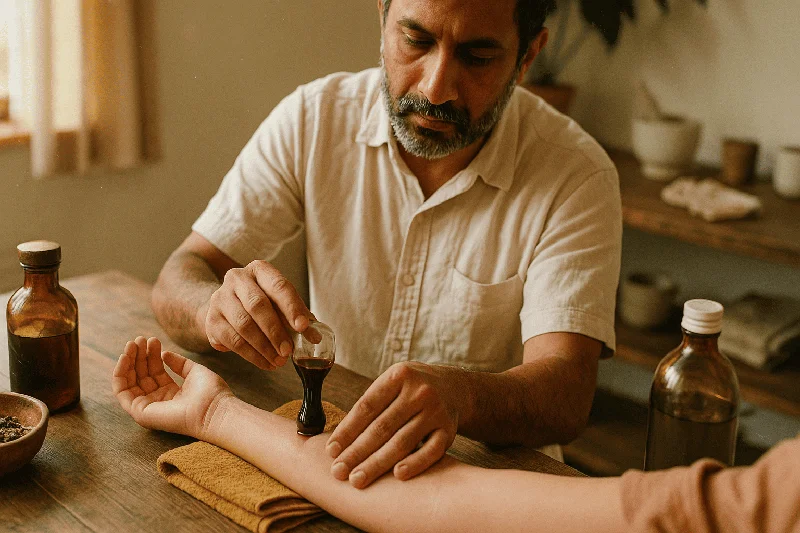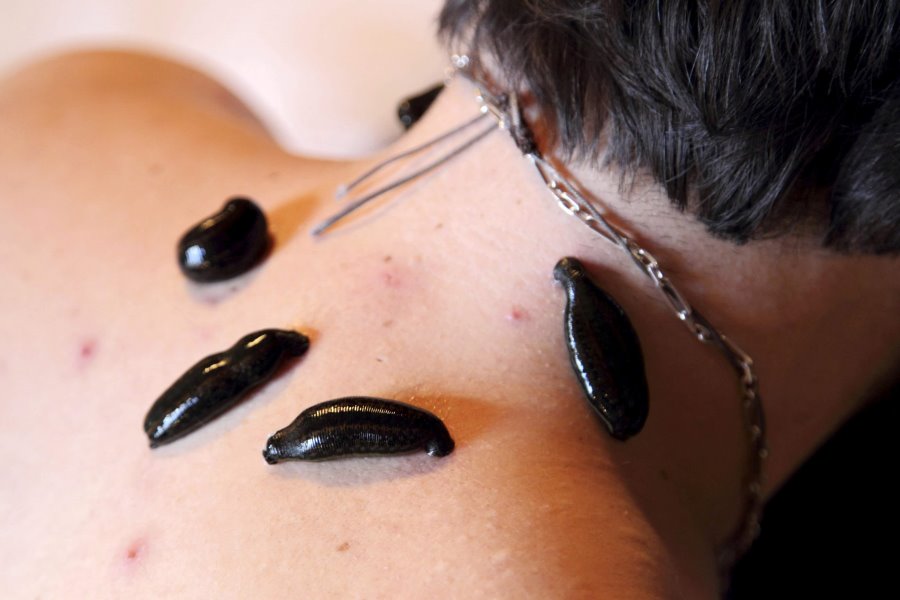Ask Ayurvedic doctor a question and get a consultation online on the problem of your concern in a free or paid mode. More than 2,000 experienced doctors work and wait for your questions on our site and help users to solve their health problems every day.
Shop Now in Our Store
Raktamokshana in Ayurveda: A Comprehensive Overview

Raktamokshana, often described as therapeutic bloodletting in Ayurveda, has intrigued practitioners and researchers for centuries. Imagine a therapeutic technique that aims to purify the bloodstream, manage inflammation, and balance the body’s innate humoral framework—all by strategically releasing a small quantity of blood. While this concept may sound ancient, modern science increasingly explores whether this time-honored practice has a place in today’s integrated healthcare. In this article, you will discover the history, scientific rationale, procedures, and contemporary evidence surrounding raktamokshana in Ayurveda. We will also provide you with practical tips, research insights, safety considerations, and FAQs to guide informed decision-making.
Table of Contents
-
Introduction to Raktamokshana
-
Historical Roots and Classical Texts
-
Mechanism of Action: Ayurvedic and Biomedical Perspectives
-
Types of Raktamokshana
-
Modern Research and Clinical Evidence
-
Indications, Benefits, and Potential Risks
-
Step-by-Step Procedure
-
Clinical Guidelines and Safety Measures
-
Integration with Other Therapies
-
Frequently Asked Questions (FAQ)
-
Conclusion and Key Takeaways
Introduction to Raktamokshana
Raktamokshana is a Sanskrit term composed of “rakta,” meaning blood, and “mokshana,” meaning to let or release. It forms a part of the Panchakarma therapies in Ayurveda—the five main procedures aimed at detoxification and rejuvenation. The process involves removing a controlled volume of blood from the body to alleviate symptoms of diseases like skin disorders, inflammatory conditions, and even chronic pain, depending on the approach and clinical judgment. While raktamokshana is deeply rooted in ancient Indian medical traditions, it also resonates with certain modern techniques such as therapeutic phlebotomy, a procedure used in contemporary medicine to manage conditions like hemochromatosis and polycythemia vera. This parallel has captured the attention of researchers seeking to understand whether these Ayurvedic approaches have valid, evidence-based applications in modern practice.
Historical Roots and Classical Texts
The Charaka Samhita and Sushruta Samhita—two foundational Ayurvedic treatises—contain comprehensive discussions about raktamokshana. Sushruta, often referred to as the “father of surgery,” detailed the physiological rationale for bloodletting and suggested that vitiated blood (impure blood) is a root cause of numerous ailments.
-
Charaka Samhita: Emphasizes the role of balanced doshas (Vata, Pitta, and Kapha) and highlights how blood impurities can disrupt bodily harmony.
-
Sushruta Samhita: Provides an extensive surgical perspective, outlining specific sites for bloodletting and techniques for leech therapy (Jalauka), venesection (Siravedha), and other forms of controlled blood evacuation.
These classical texts offer not only practical guidelines but also a philosophical framework that suggests how internal cleansing may aid in restoring equilibrium.
Mechanism of Action: Ayurvedic and Biomedical Perspectives
Ayurvedic View
According to Ayurveda, raktamokshana helps remove “ama” (toxins) from the blood, thereby relieving congestion in bodily channels known as “srotas.” If the blood remains laden with impurities, it is more likely to aggravate Pitta dosha—the bio-element responsible for metabolism, heat, and inflammation in the body. By removing the tainted portion, Ayurvedic practitioners believe that systemic inflammation can be reduced and tissue-level homeostasis restored.
Biomedical Perspective
From a modern medical standpoint, therapeutic bloodletting may help decrease iron overload, a contributing factor to oxidative stress and inflammation. Clinical evidence (e.g., studies in the Journal of Clinical Medicine Research and the American Journal of Medicine) indicates that regulated blood withdrawal can improve certain metabolic parameters, reduce ferritin levels, and mitigate the risk of cardiovascular disorders in specific cases. However, it is essential to evaluate the patient’s medical background before integrating such procedures.
Types of Raktamokshana
-
Siravedha (Venesection)
-
Involves piercing or cutting a specific vein to release blood.
-
Primarily recommended for systemic issues like high Pitta conditions, migraines, or inflammatory arthritis.
-
-
Jalauka (Leech Therapy)
-
Employs medicinal leeches to suck a small amount of blood from the affected site.
-
Often used for localized inflammatory conditions, varicose veins, and certain types of skin diseases.
-
-
Shringa (Horn Therapy)
-
Utilizes the suction effect created by a hollow horn or specialized cups to draw out impure blood.
-
Helps reduce stagnation in the superficial layers.
-
-
Alabu (Cupping Therapy)
-
Similar to horn therapy but uses modern cups.
-
Known in Western contexts as “dry or wet cupping,” though wet cupping often involves minimal incision for enhanced blood flow.
-
-
Ghati (Gourd Therapy)
-
A more traditional method similar to cupping but employs a cut gourd shell.
-
Rarely used in contemporary settings but still recognized in classical Ayurvedic texts.
-
Each method targets specific dosha imbalances or disease conditions, thus illustrating the individualized approach Ayurveda is known for.
Modern Research and Clinical Evidence
In recent years, an increasing number of peer-reviewed studies have attempted to unpack the mechanisms and efficacy of raktamokshana:
-
A 2019 pilot study published in the Journal of Ayurveda and Integrative Medicine (available on PubMed) indicated that leech therapy (jalauka) showed promising results in reducing pain and swelling in osteoarthritis patients, though larger-scale trials are needed for conclusive evidence.
-
Another systematic review in 2021 from the Complementary Therapies in Medicine journal analyzed multiple Ayurvedic case studies, finding varying degrees of benefit in treating dermatological conditions. However, the authors called for randomized controlled trials to validate these findings on a broader scale.
-
Modern clinical guidelines on therapeutic phlebotomy from recognized medical institutions like the American Society of Hematology highlight the importance of patient selection, monitoring hemoglobin and ferritin levels, and ensuring sterility—a principle that echoes Ayurvedic emphasis on patient constitution (prakriti) and doshic imbalance.
While the available data is promising, medical experts agree on one thing: more high-quality, large-scale clinical trials are necessary to fully establish the safety and efficacy of raktamokshana in different populations.
Indications, Benefits, and Potential Risks
Common Indications
-
Skin Disorders (e.g., eczema, psoriasis, acne)
-
Musculoskeletal Pain (e.g., arthritis, gout)
-
Varicose Veins and Hemorrhoids
-
Chronic Inflammatory States (depending on the practitioner’s assessment)
Potential Benefits
-
Detoxification: May help remove accumulated metabolic byproducts.
-
Anti-Inflammatory Effects: Lowering certain inflammatory markers in specific conditions.
-
Improved Circulation: Enhanced blood flow post-procedure.
-
Reduction in Pain and Swelling: Especially seen in localized therapies like jalauka.
Potential Risks
-
Infection: If performed under non-sterile conditions.
-
Excessive Blood Loss: Must be strictly controlled to prevent anemia or shock.
-
Allergic Reactions: Particularly with leech therapy (though rare).
-
Inadequate Evidence for Some Conditions: Lack of large-scale studies makes efficacy uncertain.
A thorough medical evaluation is paramount before undergoing bloodletting therapy. This includes checking hemoglobin levels, coagulation status, and other relevant clinical parameters.
Step-by-Step Procedure
Although specifics vary depending on the type of raktamokshana and the practitioner’s protocol, below is a general outline:
-
Initial Consultation:
-
The Ayurvedic practitioner evaluates the patient’s constitution (prakriti), doshic imbalance, and medical history.
-
Modern medical tests (blood count, coagulation profile, iron levels) may be recommended.
-
-
Preparation:
-
The area is disinfected if a localized method like leech therapy or cupping is used.
-
In some cases, mild sedation or a numbing agent is provided for comfort.
-
-
Application of Method:
-
Leech Therapy (Jalauka): Medicinal leeches are carefully placed on the selected site. They latch on and withdraw blood until they naturally detach.
-
Venesection (Siravedha): A vein is located, and a sterile needle or surgical instrument is used to draw out the necessary amount of blood.
-
Cupping/Horn Therapy (Alabu/Shringa): Cups or horns create suction on the skin, and small incisions may be made to allow blood flow.
-
-
Monitoring:
-
Practitioners closely monitor the volume of blood lost, patient vitals, and any signs of discomfort or adverse reaction.
-
-
Post-Procedure Care:
-
A sterile dressing or bandage is applied.
-
The patient may be advised to rest, stay hydrated, and consume a balanced diet to support recovery.
-
-
Follow-Up:
-
Follow-up visits help assess efficacy (reduction in symptoms) and safety (checking for infections or anemia).
-
Additional Ayurvedic or modern interventions may be recommended for holistic care.
-
Clinical Guidelines and Safety Measures
-
Sterility: Instruments, whether modern or traditional, should be sterilized. Leeches should be sourced from medical-grade suppliers to minimize infection risk.
-
Patient Selection: Individuals with anemia, bleeding disorders, or low immunity should avoid raktamokshana unless advised otherwise by a qualified healthcare professional.
-
Professional Supervision: Must be performed by licensed practitioners who have expertise in both Ayurveda and, ideally, some grounding in conventional medicine.
-
Monitoring: Continuous observation of vitals, hemoglobin levels, and overall patient response is crucial.
Authoritative bodies like the World Health Organization (WHO) advocate for evidence-based integration of traditional medicine, provided that patient safety and ethical guidelines are strictly observed. Always consult a certified practitioner and a primary healthcare provider before undergoing any invasive procedure.
Integration with Other Therapies
Raktamokshana rarely stands alone in Ayurvedic practice. It’s commonly paired with:
-
Herbal Remedies (e.g., Turmeric, Neem, Ashwagandha): Known for their anti-inflammatory and detoxifying properties.
-
Dietary Adjustments: A Pitta-pacifying diet (cooling foods, reduced spicy intake) is often recommended.
-
Lifestyle Modifications: Incorporating Yoga, Pranayama, and stress management can enhance the overall outcome.
-
Modern Medical Treatments: Some practitioners collaborate with allopathic doctors, especially in chronic diseases requiring multifaceted care.
This multimodal approach aims to address the root cause of illness rather than simply alleviating symptoms.
Frequently Asked Questions (FAQ)
-
Is raktamokshana painful?
-
Most patients experience mild discomfort, especially during procedures like venesection or leech attachment. Local anesthetics or numbing methods can minimize pain.
-
-
How many sessions do I need?
-
Treatment frequency varies based on individual diagnosis and the severity of the condition. Some patients require only one or two sessions, while others may need multiple over weeks or months.
-
-
Are there any dietary restrictions after the procedure?
-
Yes. Ayurveda typically recommends light, easily digestible meals (e.g., soups, cooked vegetables, rice) for a day or two post-procedure. Hydration is crucial.
-
-
Can I combine raktamokshana with conventional treatments?
-
In many cases, yes. However, consult both your Ayurvedic practitioner and primary physician to ensure no contraindications or conflicts in treatment protocols.
-
-
Is it safe for everyone?
-
Certain populations—like pregnant women, patients with severe anemia, or those on anticoagulants—may need to avoid or heavily modify the procedure. Professional medical advice is a must.
-
Conclusion and Key Takeaways
Raktamokshana in Ayurveda offers a fascinating intersection between ancient wisdom and modern healthcare principles. From Sushruta’s meticulous guidelines on bloodletting to contemporary clinical insights on therapeutic phlebotomy, this practice showcases how a well-structured, evidence-informed approach can potentially bridge traditional and modern medicine. While preliminary research points to its benefits in managing chronic inflammation, skin disorders, and certain circulatory conditions, rigorous scientific trials remain essential for broader acceptance and standardization. If you’re considering raktamokshana for a specific health issue, consult both an Ayurvedic expert and a qualified healthcare professional to ensure personalized, safe, and effective care. Proper screening, sterile techniques, and continuous monitoring form the cornerstone of a successful outcome.
Call to Action:
-
Share this article with peers or family members who are curious about integrative medical therapies.
-
Comment below on your experiences or questions regarding raktamokshana in Ayurveda.
-
Subscribe to our newsletter for the latest updates in holistic healthcare, research findings, and expert interviews.
Medical Disclaimer
This content is for educational purposes only and should not be considered a substitute for professional medical advice, diagnosis, or treatment. Always seek the guidance of your physician or another qualified health provider with any questions you may have regarding your health or a medical condition.
References available upon request from sources such as PubMed, WHO, CDC, and recognized medical journals.
This article is checked by the current qualified Dr Sujal Patil and can be considered a reliable source of information for users of the site.


